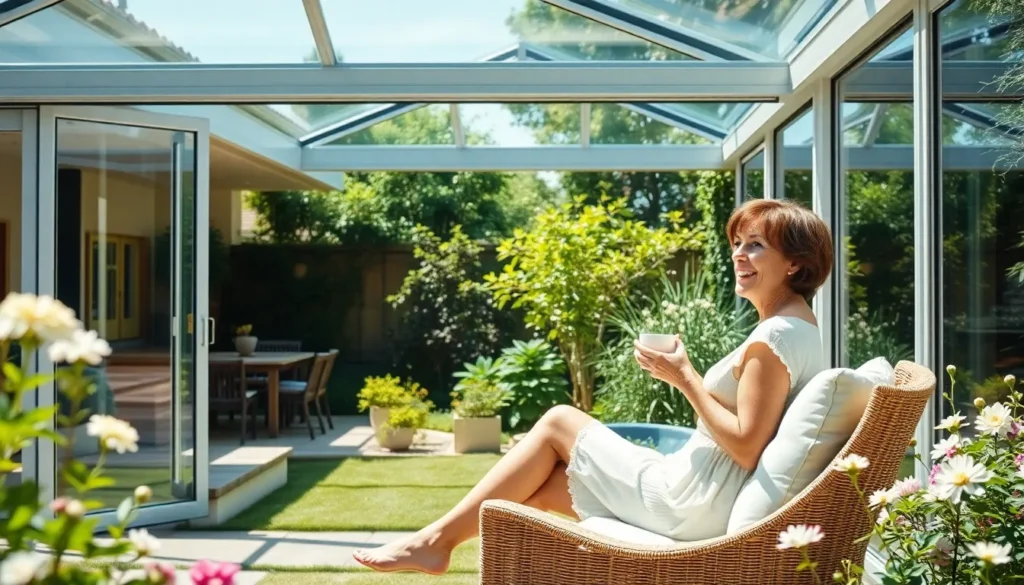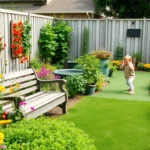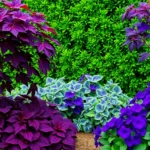We’re living in an era where home space optimization has become more crucial than ever. Garden room extensions offer the perfect solution for homeowners seeking additional living space without the complexity and expense of traditional home additions.
These versatile outdoor structures transform unused garden areas into functional spaces that seamlessly blend indoor comfort with outdoor tranquility. Whether you’re dreaming of a home office retreat, an art studio, or a cozy entertainment space, garden rooms provide endless possibilities for expanding your living environment.
What makes garden room extensions particularly appealing is their flexibility and relatively quick installation process. We’ll explore innovative design concepts that maximize both functionality and aesthetic appeal while adding important value to your property. From modern glass pavilions to rustic timber retreats, there’s a garden room style that perfectly complements every home and lifestyle.
Modern Glass Garden Room Extensions for Year-Round Use
Glass construction transforms garden rooms into luminous spaces that blur the boundaries between indoor and outdoor living. These contemporary extensions maximize natural light while providing the comfort and protection needed for four season enjoyment.
Floor-to-Ceiling Windows for Maximum Natural Light
Expansive glazing creates an immersive garden experience that brings the outdoors inside throughout every season. We recommend double or triple glazed units that extend from floor to ceiling, eliminating visual barriers and flooding your space with natural illumination. Large glass panels measuring 8 to 12 feet in height create dramatic sight lines while maintaining thermal efficiency ratings of 0.25 U-value or better.
Strategic window placement amplifies morning and afternoon light patterns in your garden room extension. Corner glazing systems work particularly well for capturing light from multiple angles, while south facing orientations provide consistent illumination during shorter winter months. Many homeowners discover that floor to ceiling windows reduce their reliance on artificial lighting by up to 60% during daylight hours.
Specialized glass options enhance both comfort and functionality in modern garden room designs. Low-E coatings reflect heat during summer while retaining warmth in winter, and self cleaning glass surfaces reduce maintenance requirements. Tinted or frosted panels offer privacy without sacrificing natural light transmission when positioned strategically around seating or workspace areas.
Bi-Fold Doors That Open to Your Garden
Multi panel bi fold systems create seamless transitions between your garden room and outdoor industry when weather permits. We’ve found that 3 to 5 panel configurations work best for most extensions, with individual panels measuring 24 to 36 inches wide for easy operation. These door systems can open up to 90% of a wall section, effectively doubling your usable space during pleasant weather.
Smooth operation mechanisms ensure your bi fold doors function effortlessly regardless of panel size or weight. Look for systems with stainless steel track hardware and adjustable roller assemblies that support panels weighing up to 220 pounds each. Quality installations include weather sealing gaskets and multi point locking systems that maintain security while providing superior insulation when closed.
Integration planning maximizes the impact of bi fold door installations in garden room extensions. Threshold options include flush sills that create level transitions to outdoor patios or decking, while raised sills provide better weather protection. Many designs incorporate fixed glazed panels alongside operable sections to maintain structural integrity while achieving the desired opening width.
Climate Control Systems for All Seasons
Efficient heating answers maintain comfortable temperatures in glass garden rooms without excessive energy consumption. We recommend radiant floor heating systems that distribute warmth evenly while remaining invisible, or compact heat pump units that provide both heating and cooling capabilities. Properly sized systems typically require 30 to 50 BTU per square foot for adequate temperature control in well insulated glass structures.
Ventilation strategies prevent condensation and maintain air quality in year round garden room extensions. Natural ventilation through operable roof lights or side vents provides fresh air circulation, while mechanical systems offer precise humidity control. Automated louvre systems can open and close based on temperature sensors, maintaining optimal conditions without manual intervention.
Smart climate management integrates heating, cooling, and ventilation systems for seamless operation throughout changing seasons. Programmable thermostats allow you to pre condition your garden room before use, while zone control systems adjust temperatures based on occupancy patterns. Integration with home automation platforms enables remote monitoring and adjustment of climate settings from anywhere.
Traditional Conservatory-Style Garden Room Additions
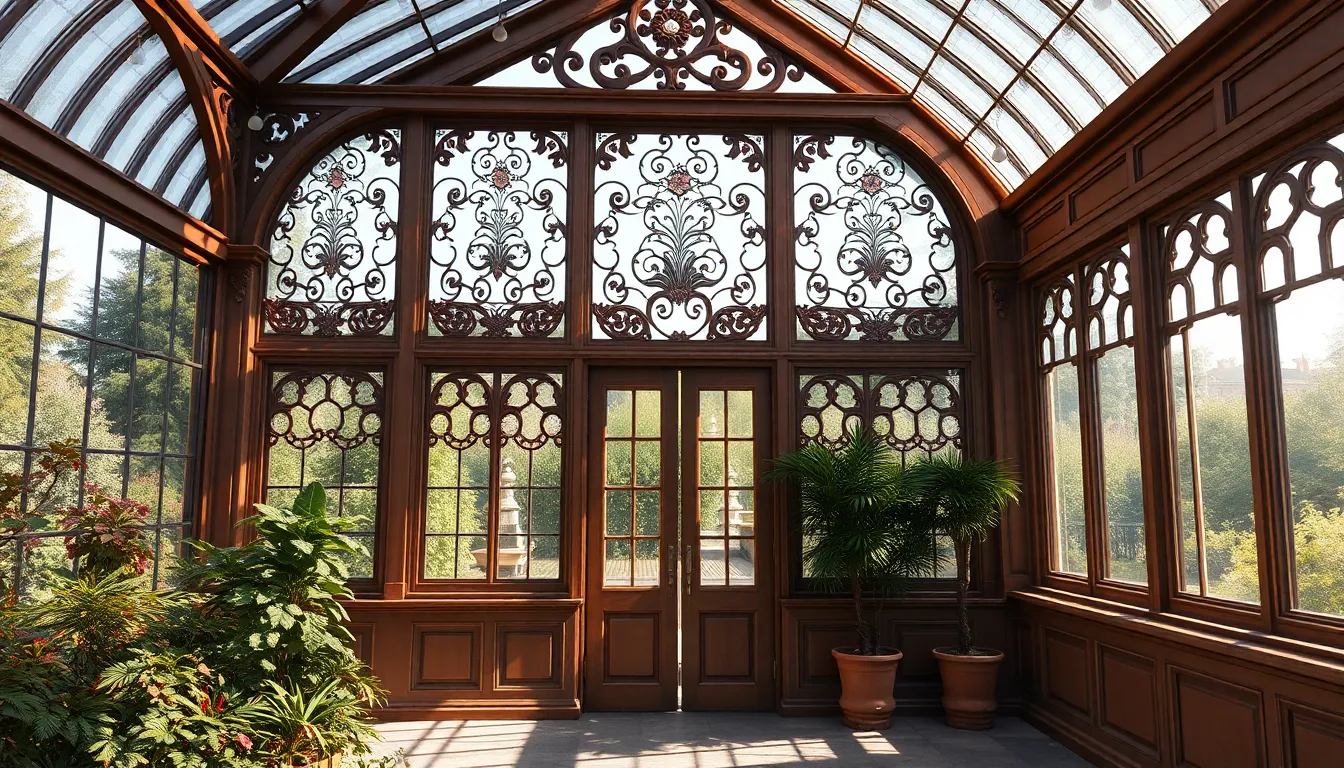
We’re diving into timeless designs that bring elegance and natural light to your outdoor living space. Traditional conservatory styles offer classic appeal with modern functionality.
Victorian-Inspired Glass Structures
Victorian garden rooms showcase ornate woodwork and decorative glass features that create stunning focal points in any garden. These structures feature intricate detailing that adds sophistication and elegance to your outdoor space.
Ornate design elements include carved brackets, decorative ridge cresting, and elaborate finials that capture the grandeur of the Victorian era. The aesthetic appeal of these glass structures transforms ordinary gardens into extraordinary retreats with their distinctive architectural character.
Traditional Victorian conservatories often incorporate bay-fronted designs that maximize interior space while creating dramatic external silhouettes. Multi-pane glass panels with decorative glazing bars add authentic period charm that complements heritage properties beautifully.
Edwardian Design Elements and Features
Edwardian garden rooms emphasize clean lines and minimal embellishments while maintaining classic elegance throughout their design. These structures feature less ornate styling compared to Victorian alternatives but deliver timeless sophistication that suits contemporary tastes.
Simplistic yet elegant proportions define Edwardian conservatories with their rectangular or square floor plans and gently sloping roofs. Large windows maximize sunlight penetration and garden views while creating bright, airy interiors perfect for year-round enjoyment.
Practical design considerations include wider door openings and improved ventilation systems that enhance comfort and accessibility. The balanced proportions and symmetrical features create harmonious connections between your home and garden spaces.
Classic White Framework Options
Classic white frameworks create bright and airy environments that amplify natural light throughout your garden room extension. This versatile color choice complements various garden settings while maintaining a fresh, clean appearance that never goes out of style.
White powder-coated aluminum or uPVC frames offer durability and low maintenance requirements while delivering crisp, professional aesthetics. The bright framework enhances the sense of space and creates seamless integration with both traditional and modern architectural styles.
Versatile white structures blend effortlessly with existing home exteriors and garden landscapes, from cottage-style properties to contemporary residences. These timeless frameworks reflect light effectively, creating luminous interiors that feel spacious and welcoming throughout all seasons.
Multi-Purpose Garden Room Extension Designs
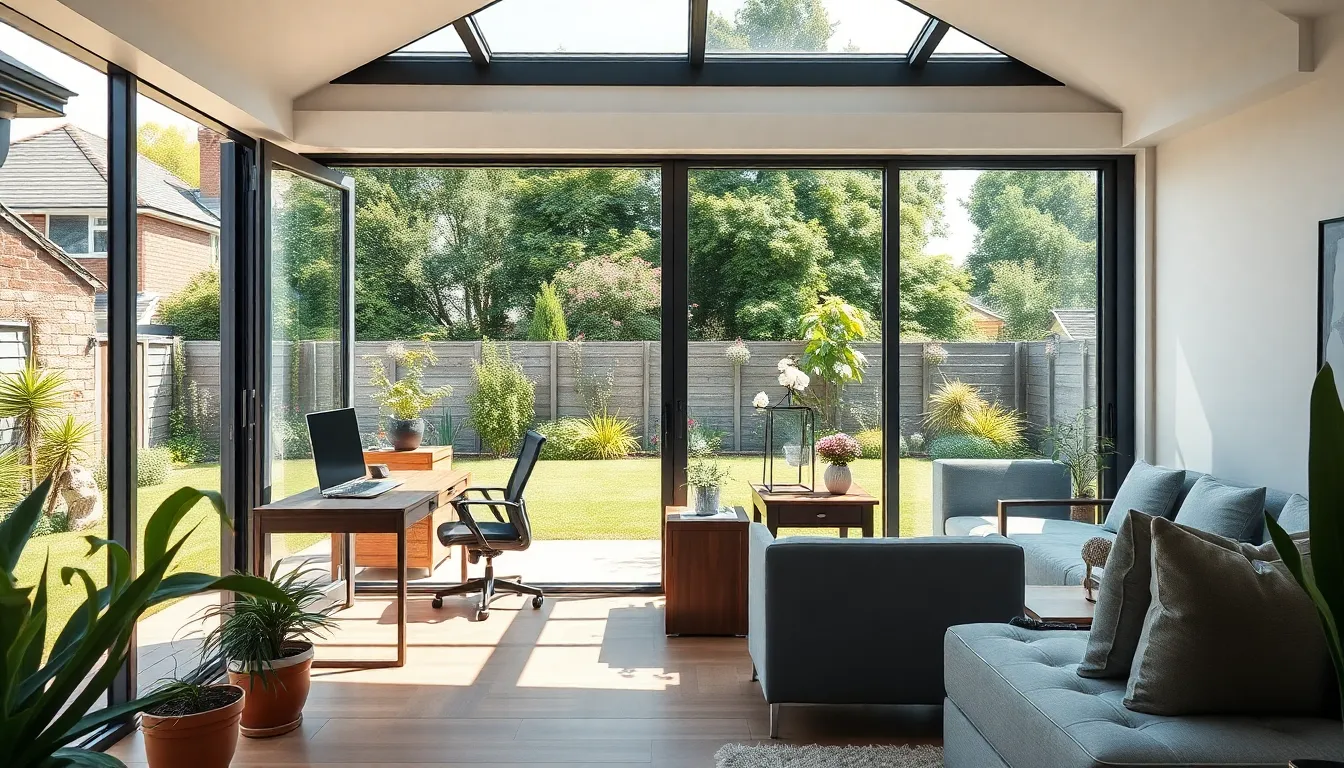
Garden room extensions offer remarkable versatility, allowing homeowners to create customized spaces that adapt to multiple functions throughout the day. We’ll explore how these flexible structures can transform your outdoor area into highly functional living spaces.
Home Office and Study Spaces
Dedicated workspace creation becomes effortless with garden room extensions that provide the perfect environment for remote work. These structures offer a dedicated space away from the main house, significantly improving work-life balance by creating physical separation between professional and personal areas.
Natural lighting optimization enhances productivity in garden office settings through strategically placed windows and glass panels. We recommend incorporating large glass sliding doors to create panoramic views while maintaining focus and reducing eye strain during long work sessions.
Study area configuration transforms garden rooms into quiet learning environments with comfortable seating arrangements and ample task lighting. Students and professionals alike benefit from the peaceful atmosphere these spaces provide, free from household distractions and interruptions.
Entertainment and Dining Areas
Games room development creates an immersive entertainment experience separate from the main house, perfect for board games, poker nights, or casual gatherings. These spaces offer complete privacy for social activities while maintaining easy access to outdoor areas through connecting decks or patios.
Outdoor kitchen integration enhances the home’s value while providing the perfect venue for hosting dinner parties in a natural setting. We’ve seen homeowners successfully combine cooking facilities with dining areas, creating seamless entertainment zones that flow between indoor and outdoor spaces.
Extended dining experiences use garden rooms as natural extensions of existing dining areas, ideal for both casual family meals and special occasion celebrations. The connection to outdoor living areas through decking, courtyards, or patios creates a cohesive entertaining environment that guests remember.
Gym and Wellness Retreat Rooms
Home gym conversion transforms garden rooms into peaceful workout spaces that provide privacy and tranquility for exercise routines. These dedicated fitness areas offer the perfect solution for maintaining health and wellness goals without the need for gym memberships or crowded public facilities.
Wellness retreat design incorporates meditation areas and yoga spaces that promote relaxation and mindfulness practices. We recommend utilizing the full height of garden rooms to create an open, airy atmosphere that enhances the sense of calm and spiritual connection.
Multi-functional wellness spaces combine exercise equipment with relaxation zones, allowing users to transition seamlessly between active workouts and restorative activities. The natural light and garden views create an inspiring environment that motivates consistent use throughout the year.
Sustainable and Eco-Friendly Garden Room Ideas
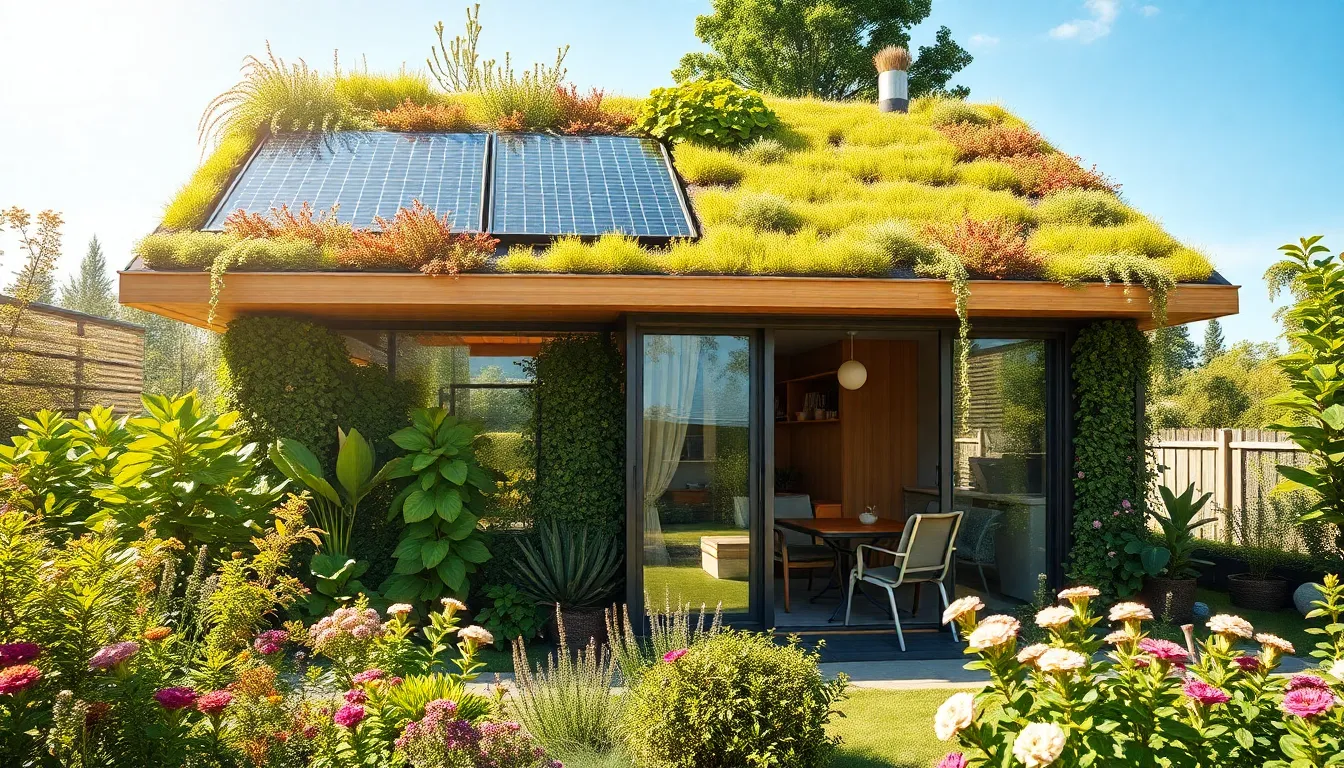
Garden room extensions present remarkable opportunities to embrace environmental responsibility while creating beautiful functional spaces. We can significantly reduce our ecological footprint by incorporating sustainable design elements and eco-friendly materials into these versatile structures.
Solar Panel Integration Options
Energy harvesting becomes effortless when we integrate solar panels directly into our garden room roof design. These renewable energy systems generate electricity that reduces our reliance on traditional power sources while cutting energy costs substantially.
Design considerations play a crucial role in maintaining aesthetic appeal during solar installation. We achieve seamless integration by selecting panels that complement the room’s architectural style and preserve the natural connection between indoor and outdoor spaces.
Aesthetic integration ensures our solar panels enhance rather than detract from the overall garden room appearance. Strategic placement on south-facing roof sections maximizes energy production while maintaining visual harmony with surrounding industry elements.
Green Roof and Living Wall Features
Green roofs transform ordinary garden room extensions into living ecosystems that provide exceptional insulation benefits. These sustainable features reduce stormwater runoff by absorbing rainwater naturally while creating valuable habitats for local wildlife species.
Wildlife habitats flourish on green roof installations through carefully selected native plant varieties. We support biodiversity by choosing drought-resistant plants that require minimal maintenance while attracting beneficial insects and birds to our garden spaces.
Living walls enhance our garden rooms by improving indoor air quality through natural filtration processes. These vertical gardens create stunning visual connections between interior spaces and outdoor environments while supporting local network health.
Air quality improvements occur naturally as living wall plants filter pollutants and produce fresh oxygen. We experience better indoor environments while contributing to broader environmental sustainability goals through these innovative green features.
Recycled and Sustainable Building Materials
Recycled materials offer countless possibilities for creating unique garden room elements while reducing construction waste. We incorporate recycled glass, plastic, and metal components into countertops, decorative features, and structural elements that showcase environmental consciousness.
Sustainable timber choices include FSC-certified wood and reclaimed lumber that maintains structural integrity while supporting responsible forestry practices. These materials provide authentic character and reduce demand for newly harvested timber resources.
Construction waste minimization becomes achievable through careful planning and material selection strategies. We carry out building practices that recycle construction leftovers and optimize material usage to reduce overall environmental impact significantly.
Environmental partnerships with organizations like One Tree Planted demonstrate commitment to reforestation efforts beyond individual projects. Companies such as Crown Pavilions actively support environmental restoration while delivering sustainable garden room answers for environmentally conscious homeowners.
Budget-Friendly Garden Room Extension Solutions
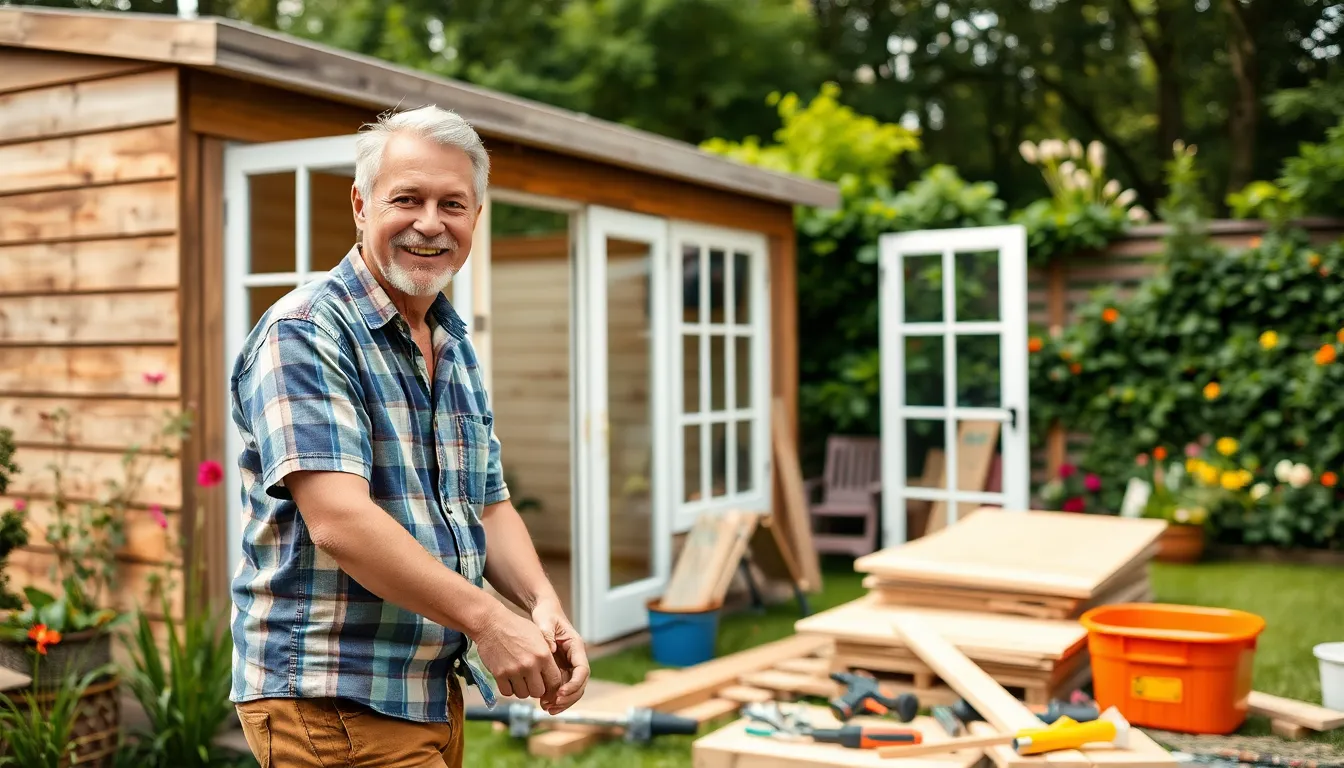
Creating a beautiful garden room extension doesn’t have to expensive. We’ve identified several cost-effective approaches that can help you achieve your dream outdoor space while maintaining control over your budget.
DIY Kit Options and Self-Build Approaches
Pre-fabricated garden room kits offer an excellent starting point for budget-conscious homeowners. These comprehensive packages typically include walls, roofing systems, and doors that can be assembled on-site without professional contractors. We find that DIY kits are available in various sizes and architectural styles, providing flexibility to match your exact needs and garden dimensions.
Self-build projects present another attractive option for reducing overall costs. Purchasing individual components separately allows for greater customization while keeping expenses manageable. We recommend starting with basic structural elements like timber framing and gradually adding features such as windows, insulation, and interior finishes as your budget permits.
Material selection plays a crucial role in controlling project expenses. Reclaimed wood offers both durability and affordability, creating character while reducing costs significantly. Low-cost insulation options can maintain comfort without compromising your financial goals, and we’ve seen homeowners achieve excellent results with strategic material choices.
Repurposed Structure Conversions
Converting existing outdoor structures provides one of the most economical paths to garden room ownership. Sheds and garages can be transformed into cozy living spaces through strategic additions of windows, proper insulation, and electrical connections. We’ve observed that these conversions often cost 40-60% less than new construction while delivering comparable functionality.
Greenhouse conversions represent another innovative approach to budget-friendly extensions. Adding insulation and climate control systems like heating and cooling can transform these structures into year-round living spaces. We recommend evaluating the structural integrity of existing greenhouses before beginning conversion work to ensure safety and longevity.
Existing structures already have foundations and basic frameworks in place, which eliminates important construction costs. We suggest consulting with local building professionals to assess conversion feasibility and ensure compliance with local building codes and regulations.
Phased Construction Planning Strategies
Breaking your garden room project into manageable phases spreads costs over time while maintaining steady progress. Phase 1 should focus on planning and foundation work, establishing a solid base for your extension. We recommend investing time in detailed planning during this stage to avoid costly modifications later in the process.
Phase 2 involves framing and component installation, whether you’re working with pre-fabricated elements or building from scratch. We find that homeowners can often complete this phase over several weekends, further reducing labor expenses. Proper sequencing ensures each step builds logically on the previous work.
Phase 3 encompasses finishing touches including interior finishes, electrical connections, and any necessary plumbing or HVAC installations. We suggest prioritizing essential systems first, then adding luxury features as budget allows. This approach ensures your garden room becomes functional quickly while leaving room for future enhancements.
Timeline flexibility allows you to take advantage of seasonal sales on materials and equipment. We’ve seen homeowners save 20-30% on total project costs by purchasing materials during off-peak periods and completing work during favorable weather conditions.
Luxury High-End Garden Room Extension Concepts
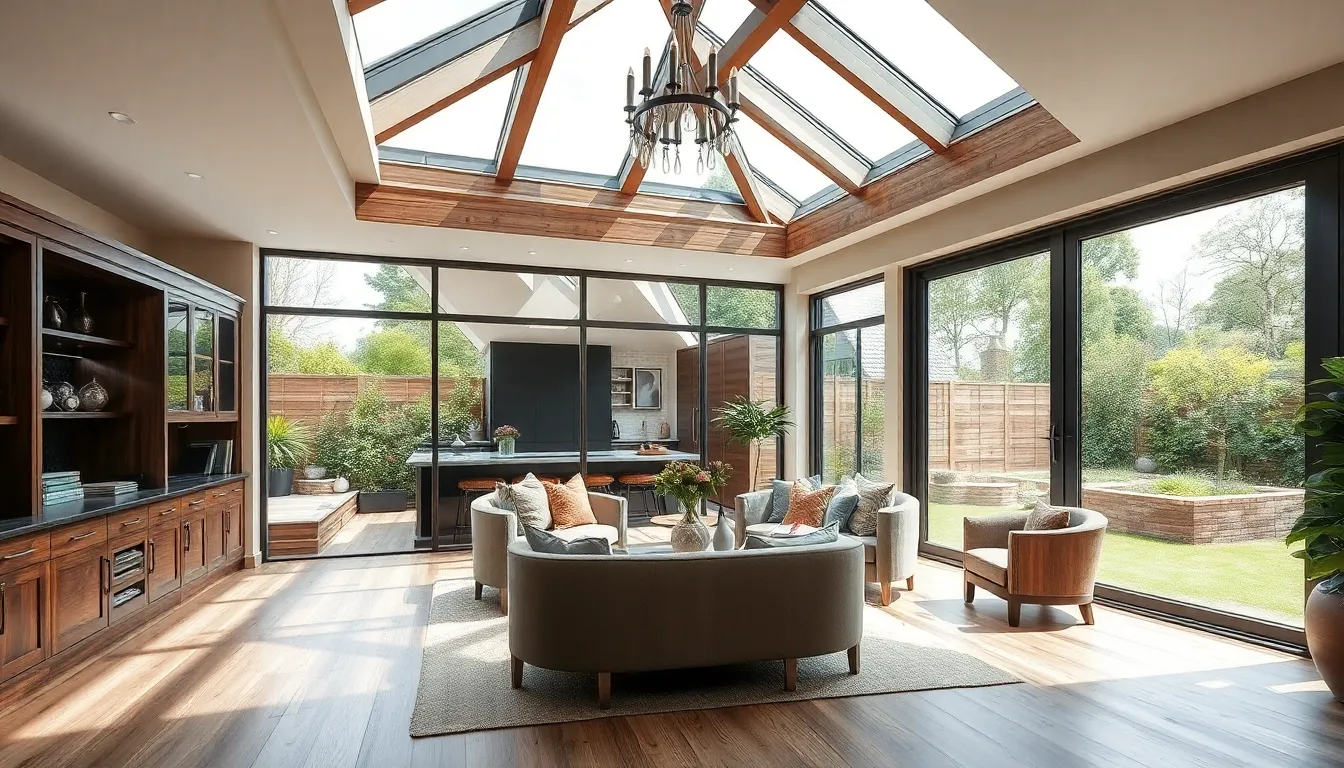
Elevating your outdoor living space to luxury standards involves incorporating premium features that transform a simple garden room into an extraordinary extension. We’ve carefully curated the most sophisticated approaches that combine cutting-edge technology with exquisite craftsmanship.
Smart Home Technology Integration
Modern luxury garden rooms seamlessly integrate intelligent systems that enhance both functionality and convenience throughout your extended living space. Smart lighting systems allow us to control ambient settings remotely, creating perfect atmospheres for work, relaxation, or entertainment at the touch of a button. Temperature regulation becomes effortless through automated climate control systems that maintain optimal comfort levels year-round.
Entertainment systems can be fully integrated into the garden room’s design, with speakers built into walls and ceiling structures for immersive audio experiences. Automated window treatments respond to sunlight levels and privacy needs, while security systems provide peace of mind through smart monitoring capabilities. Voice-activated assistants coordinate all these systems, making your luxury garden room respond intuitively to your daily routines.
Premium Materials and Finishes
Exceptional garden rooms showcase the finest materials that combine durability with stunning visual appeal. High-quality timber frames, such as European oak or sustainable hardwoods, create structural elegance while providing superior insulation properties. Large glass panels with triple glazing maximize natural light penetration while maintaining energy efficiency standards.
Stone accents and feature walls add textural richness, with options including natural slate, limestone, or contemporary engineered stone surfaces. Luxurious flooring selections range from heated natural stone tiles to premium engineered hardwood that withstands temperature fluctuations. Bespoke interior design elements, including custom cabinetry and built-in furniture, ensure every detail reflects your personal style preferences.
Metal finishes in brushed aluminum or powder-coated steel provide modern sophistication while requiring minimal maintenance over time. Premium roofing materials, such as standing seam metal or high-performance membrane systems, offer both aesthetic appeal and long-term weather protection.
Custom Architectural Design Features
Distinctive architectural elements transform standard garden rooms into extraordinary luxury extensions that complement your home’s existing character. Vaulted ceilings create dramatic vertical space while incorporating exposed structural beams that add visual interest and architectural authenticity. Unique window configurations, including corner glazing systems and clerestory windows, maximize views while creating striking geometric patterns.
Bespoke entrance features, such as oversized pivot doors or custom-designed glass portals, make impressive statements while facilitating seamless indoor-outdoor transitions. Architectural details like decorative corbels, custom millwork, and integrated planters blur the boundaries between structure and industry design.
Advanced construction techniques enable complex geometries and cantilevers that appear to defy gravity, creating spaces that feel both grounded and ethereal. Custom skylights and roof lanterns flood interiors with natural light while serving as stunning focal points that draw the eye upward, emphasizing the room’s luxurious proportions.
Small Space Garden Room Extension Ideas
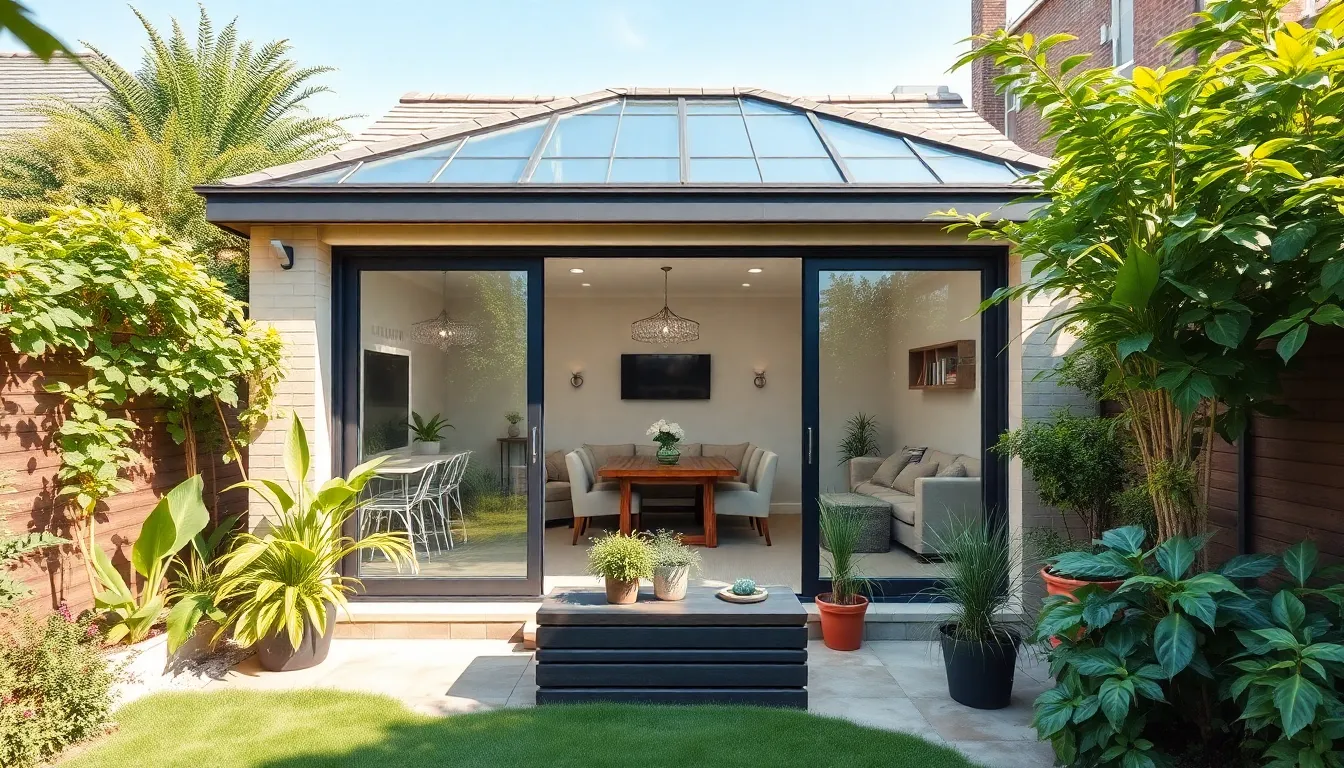
Creating a functional garden room extension doesn’t require vast outdoor space. We’ll explore innovative answers that maximize every square foot while delivering exceptional results.
Compact Design Answers for Limited Areas
Lean-to designs offer the most space-efficient approach for small gardens, utilizing existing walls and requiring minimal ground footprint. These structures feature glass panels similar to conservatories but demand less budget and space compared to full garden room extensions.
Panoramic views become possible through large glass sliding doors that create seamless transitions between indoors and outdoors. This design technique visually expands the interior space while maintaining the garden room’s compact footprint.
Landscaping integration helps blend your garden room with existing outdoor spaces by positioning plants both inside and outside the structure. Strategic placement of greenery creates visual continuity that makes small spaces appear larger.
Shared materials between your garden room and outdoor areas establish cohesive design flow. Stone tiles, wooden decking, or brick pathways used consistently throughout both spaces create unified aesthetics that enhance spatial perception.
Freestanding garden rooms work exceptionally well in underutilized garden corners, transforming neglected areas into functional spaces without expanding your property’s footprint. These structures can be positioned strategically to maximize privacy and garden views.
Vertical Space Maximization Techniques
Double-story garden rooms use vertical space effectively by building multi-level structures that provide significantly more interior options. Upper levels can accommodate storage, home offices, or additional living areas while maintaining a small ground footprint.
Wall space optimization becomes crucial in compact garden rooms through open shelving systems and built-in storage answers. Smart storage options like in-stair drawers maximize functionality without cluttering the limited floor area.
High ceilings create dramatic vertical space that makes small garden rooms feel significantly larger. Vaulted or cathedral ceiling designs draw the eye upward while providing opportunities for clerestory windows that flood the space with natural light.
Mezzanine levels offer creative answers for adding workspace or storage areas without expanding the garden room’s foundation. These partial upper floors provide additional square footage while maintaining open, airy feelings below.
Multi-Level Garden Room Structures
Double-story designs provide ample space for diverse functions including living areas, storage, and dedicated work zones. These structures can accommodate home offices on upper levels while maintaining entertainment spaces below.
Roof utilization enhances both functionality and sustainability through solar panel installations or green roof systems. Flat roof designs particularly suit solar panel integration while providing additional eco-friendly benefits.
Staircase design becomes a focal point in multi-level garden rooms, with options ranging from space-saving spiral stairs to wider traditional designs. Under-stair storage maximizes every inch of available space in these vertical structures.
Ground floor layouts in multi-level garden rooms typically focus on main living and entertainment areas, while upper floors accommodate quieter activities like reading nooks or home offices. This vertical zoning creates distinct functional areas within compact footprints.
Planning Permission and Legal Considerations
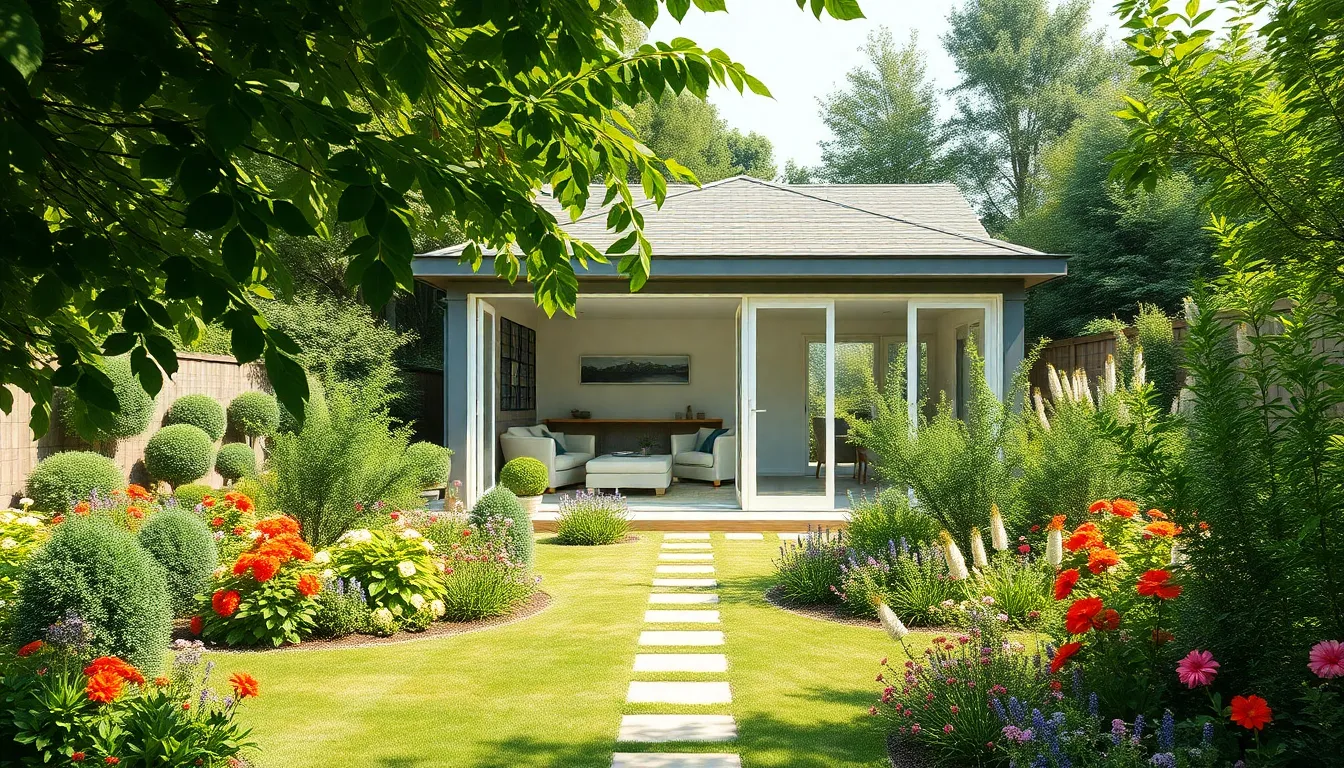
Understanding planning permission requirements protects your investment and ensures your garden room extension meets legal standards. Most garden rooms fall under permitted development rights, but exact regulations determine whether you’ll need formal planning approval.
Permitted Development Rights and Regulations
Location restrictions form the foundation of permitted development rules for garden rooms. Your extension can’t be positioned in front of your house, and if you’ve previously extended your property, we use the original front boundary from July 1, 1948, as the reference point.
Size limitations strictly control the scale of your garden room project. The total area of all outbuildings, including your new garden room, mustn’t exceed 50% of your original land area. Height restrictions vary based on roof design and proximity to boundaries.
Height specifications depend on your garden room’s roof style and location. Dual pitched roofs can reach a maximum of 4 meters, while other roof types are limited to 3 meters. Buildings within 2 meters of any boundary face stricter height limits of just 2.5 meters.
Structural requirements mandate that garden rooms remain single story structures. Eaves height cannot exceed 2.5 meters, and you can’t add balconies, verandas, or raised platforms to your design.
Special area exemptions apply to properties in National Parks, conservation areas, or listed buildings. These locations typically require planning permission regardless of size or position, so we recommend consulting your local planning authority early in the process.
Building Control Requirements
Safety compliance remains mandatory even when planning permission isn’t required. Building control regulations ensure your garden room meets structural safety standards, electrical safety requirements, and proper insulation specifications.
Foundation standards must meet building code requirements regardless of your garden room’s size. Proper footings protect against ground movement and ensure long term structural integrity of your extension.
Electrical installations require certification from qualified electricians when you’re adding power to your garden room. We recommend planning electrical layouts early to integrate seamlessly with your design while meeting safety standards.
Insulation compliance ensures your garden room meets thermal efficiency requirements. Proper insulation reduces energy costs and creates comfortable year round living spaces that add genuine value to your property.
Neighbor Consultation Guidelines
Privacy considerations should guide your garden room positioning to maintain good relationships with adjacent properties. Thoughtful placement prevents your extension from blocking existing views or creating unwanted overlooking situations.
Boundary awareness helps avoid disputes about property lines and shared fences. We suggest confirming exact boundary locations before construction begins, especially when building close to property lines.
Early communication with neighbors, while not legally required, prevents misunderstandings and potential conflicts. Sharing your plans demonstrates consideration and often leads to valuable feedback about potential concerns.
View protection matters to both your enjoyment and neighbor relations. Position windows and doors to maximize your garden views while avoiding direct sight lines into neighboring private spaces like bedrooms or secluded garden areas.
Conclusion
Garden room extensions represent one of the smartest investments we can make in our homes today. These versatile structures offer endless possibilities – from creating dedicated workspaces to luxurious entertainment areas – all while adding important value to our properties.
Whether we’re working with a modest budget or planning a high-end retreat our garden room can be customized to match our exact needs and lifestyle. The key is understanding what we want to achieve and choosing the right design approach that balances functionality with aesthetic appeal.
With proper planning and consideration of local regulations we can transform any outdoor space into a beautiful functional extension that enhances our daily living experience for years to come.
Frequently Asked Questions
What is a garden room extension?
A garden room extension is a versatile outdoor structure built in your garden to create additional living space without the complexities of traditional home additions. These structures can serve various purposes including home offices, art studios, entertainment areas, or relaxation spaces. They offer quick installation and flexible design options to transform unused garden areas into functional rooms.
Do I need planning permission for a garden room extension?
Most garden room extensions fall under permitted development rights and don’t require formal planning permission. However, there are size limitations, height specifications, and structural requirements that must be met. In certain cases, such as conservation areas or listed buildings, formal approval may be required. It’s essential to check local regulations before construction.
How much does a garden room extension cost?
Garden room extension costs vary significantly based on size, materials, and features. Budget-friendly options include DIY kits and converting existing structures like sheds or garages. Mid-range options offer better materials and professional installation, while luxury extensions with premium materials, smart technology, and custom architectural features can cost considerably more.
What are the benefits of glass garden room extensions?
Glass garden room extensions maximize natural light through floor-to-ceiling windows, creating bright and airy spaces that blend indoor and outdoor living. They reduce reliance on artificial lighting, offer specialized glass options for comfort, and can include bi-fold doors for seamless transitions. Climate control systems ensure year-round usability with efficient heating and ventilation.
Can I build a garden room extension myself?
Yes, DIY garden room extensions are possible through self-build kits that allow customization while managing expenses. These kits typically include detailed instructions and all necessary materials. However, certain aspects like electrical installations and foundation work may require professional assistance to ensure safety and building control compliance.
What materials are best for garden room extensions?
Garden room materials range from traditional timber frames to modern aluminum and uPVC options. Sustainable choices include recycled materials, eco-friendly timber, and energy-efficient glass. Premium materials like high-quality hardwood and specialized insulation offer durability and aesthetic appeal. The choice depends on budget, climate, and design preferences.
How can I make my garden room extension sustainable?
Sustainable garden room extensions can incorporate solar panels for energy efficiency, green roofs for insulation and biodiversity, living walls for air quality improvement, and recycled building materials. These eco-friendly features reduce environmental impact while potentially lowering long-term operating costs and enhancing the structure’s integration with natural surroundings.
What size garden room extension can I build?
Garden room size depends on available space, local regulations, and intended use. Compact solutions like lean-to structures work for small gardens, while larger spaces can accommodate multi-level designs. Most permitted development allows structures up to certain height and coverage limits. Vertical space maximization through mezzanine levels can increase functionality without expanding the footprint.
How do I maintain good neighbor relations when building a garden room?
Maintain good neighbor relations by consulting them early in the planning process, ensuring thoughtful placement away from boundaries, and being transparent about construction timelines. Consider the structure’s impact on their privacy and sunlight, choose appropriate heights and materials, and address any concerns proactively to avoid disputes and maintain community harmony.
Can garden room extensions be used year-round?
Yes, properly designed garden room extensions can be used year-round with appropriate climate control systems. This includes efficient heating solutions, proper insulation, ventilation strategies, and smart climate management. Quality construction with thermal glazing and weatherproofing ensures comfort in all seasons, making the space as functional as indoor rooms.

